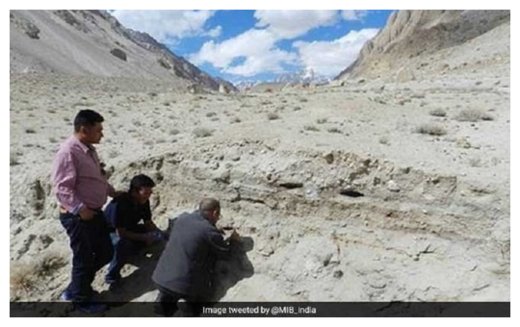
© Tweeted by @MIB_IndiaThe site was unearthed at 14,000 feet above the sea level on the way from Saser La to Ladakh.
New Delhi -
The Archaeological Survey of India (ASI) has discovered an ancient camping site dating 8500 BC in Ladakh in Jammu and Kashmir, indicating humans were camping in the area 10,500 years ago.The site was unearthed at 14,000 feet above the sea level on the way from Saser La to Ladakh, an official release said.
While exploring in Nubra valley during 2015-16, ASI Joint Director General SB Ota noticed a section, exposed due to road construction, showing successive layers comprising burning residue.
A charcoal sample collected from the site, which was sent to Beta Lab, Florida for radiocarbon, dated it back to 8500 BC.Realising the significance of the evidence, a team of ASI officials were sent for further inspection last month.
Further, charcoal samples from lower and upper deposits sent for dating have provided radiocarbon dates of 8500 BC and 7300 BC respectively, indicating repeated human activity at this camping site for about eight hundred years, the release said.
Preliminary studies of charred bones collected from the site, carried out by PP Joglekar of Deccan Collage, Pune, have shown the presence of Gorel and Yak, it added.
"The research so far carried out has proved the antiquity and nature of human activities to an extent, but their camping patterns, extent of camping area, tools and other cultural aspects are yet to be traced," the release said.
To address these issues, proper archaeological excavations and explorations are being planned by the ASI, it said adding, however, it will not be an easy task to undertake these works in such a rugged terrain at an altitude around 14000 feet, with low oxygen and no habitation.




Comment:
Mexican plants could break code on Voynich manuscript
New signs of language surface in mystery Voynich text
University of Arizona scientists carbon-date mysterious Renaissance-era document